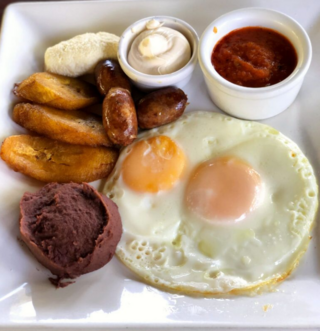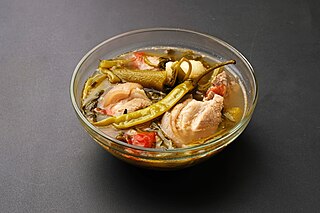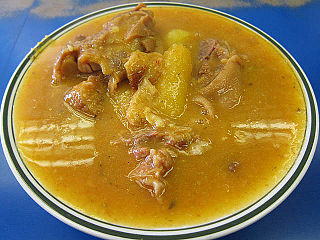
Turkish cuisine is the cuisine of Turkey and the Turkish diaspora. The cuisine took its current form after numerous cultural interactions throughout centuries, descending from earlier stages of Turkish cuisine, Ottoman cuisine and Seljuk cuisine. Turkish cuisine with traditional Turkic elements such as yogurt, ayran, kaymak, exerts and gains influences to and from Mediterranean, Balkan, Middle Eastern, Central Asian and Eastern European cuisines.

Tripe is a type of edible lining from the stomachs of various farm animals. Most tripe is from cattle, pigs and sheep.

Goulash is a soup or stew of meat and vegetables seasoned with paprika and other spices. Originating in Hungary, goulash is a common meal predominantly eaten in Central Europe but also in other parts of Europe. It is one of the national dishes of Hungary and a symbol of the country.

Offal, also called variety meats, pluck or organ meats, is the internal organs of a butchered animal. The word does not refer to a particular list of edible organs, and these lists of organs vary with culture and region, but usually exclude skeletal muscle. Offal may also refer to the by-products of milled grains, such as corn or wheat.

Menudo, also known as Mondongo, pancita or mole de panza, is a traditional Mexican soup, made with cow's stomach (tripe) in broth with a red chili pepper base. It is the Mexican variation of the Spanish callos or menudo. Similar dishes exist throughout Latin America and Europe including mondongo, guatitas, dobrada and, in Italy, trippa alla romana.
Romanian cuisine is a diverse blend of different dishes from several traditions with which it has come into contact, but it also maintains its own character. It has been influenced mainly by Turkish but also a series of European cuisines in particular from the Balkan Peninsula and Hungarian cuisine as well as culinary elements stemming from the cuisines of Central Europe.

Salvadoran cuisine is a style of cooking derived from the nation of El Salvador. The indigenous foods consist of a mix of Amerindian cuisine from groups such as the Lenca, Pipil, Maya Poqomam, Maya Chʼortiʼ, Alaguilac and Cacaopera peoples and some African influences. Many of the dishes are made with maize (corn). There is also heavy use of pork and seafood. European ingredients were incorporated after the Spanish conquest.

Sinigang is a Filipino soup or stew characterized by its sour and savory taste. It is most often associated with tamarind, although it can use other sour fruits and leaves as the souring agent such as unripe mangoes or rice vinegar. It is one of the more popular dishes in Filipino cuisine. This soup, like most Filipino dishes, is usually accompanied by rice.

Sopa de mondongo is a soup that originally came from Colombia and the Dominican Republic. It is made from diced tripe slow-cooked with vegetables such as bell peppers, onions, carrots, cabbage, celery, tomatoes, cilantro, garlic or root vegetables. The dish is generally prepared in former Spanish colonies in Latin America, Caribbean, and in the Philippines. The proposed etymology for mondongo is in the African Kikongo language, meaning “intestines, entrails of certain animals.
Montenegrin cuisine is a result of Montenegro's geographic position and its long history and tradition.
Bosnian cuisine is the traditional cuisine of Bosnia and Herzegovina. It is influenced by Ottoman, Austro-Hungarian and Balkan cuisines.

Chorba or shorba is a broad class of stews or rich soups found in national cuisines across the Middle East, Maghreb, Iran, Turkey, Southeast Europe, Central Asia, East Africa and South Asia. It is often prepared with added ingredients but served alone as a broth or with bread.

Tunisian cuisine, the cuisine of Tunisia, consists of the cooking traditions, ingredients, recipes and techniques developed in Tunisia since antiquity. It is mainly a blend of Mediterranean and native Berber cuisine with Punic influences. Historically, Tunisian cuisine witnessed influence and exchanges with many cultures and nations like Italians, Andalusians, French and Arabs.

Extremadura, Spain is known for its different ways of preparing the Iberian pork and mutton. The main characteristics of the traditional Extremaduran cuisine are its simplicity, its lack of clutter and its low cost. It is also a cuisine reflecting a generous spirit, for many of its preparations used to be cooked in large pots to share with visitors, friends, and neighbors. The resulting dishes are eaten with local bread.

Flaki or flaczki ( ) is a traditional Polish tripe stew. It is one of the many Polish soups, which represent an important part of Polish cuisine. Along with bigos, żurek, and pierogi, it is one of the most notable specialities in Polish cuisine. Its name is derived from its main ingredient: thin, cleaned strips of beef tripe.

A meatball is ground meat (mince) rolled into a ball, sometimes along with other ingredients, such as bread crumbs, minced onion, eggs, butter, and seasoning. Meatballs are cooked by frying, baking, steaming, or braising in sauce. There are many types of meatballs using different types of meats and spices. The term is sometimes extended to meatless versions based on legumes, vegetables, mushrooms, fish or other seafood.

Callos a la Madrileña is a stewed tripe dish, cooked slowly for hours over low heat, that is a speciality of Spanish cuisine associated with the city of Madrid. Traditionally pig or cow tripe was used but modern recipes use lamb or even cod. It includes pig snout and trotters, black pudding, sausage, ham, and soup vegetables like carrots and onions. When prepared correctly the broth is rich in gelatin and the tripe becomes very tender after the slow cooking process. The tripe can be browned before the cooking liquid is added, with trotter's, oxtails and other ingredients for the soup like ham, chorizo and smoked paprika. It is common to serve this stew with the morcilla blood sausage, a tapas dish typical of the region of Castile and León.




























